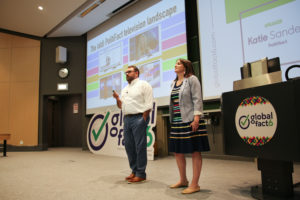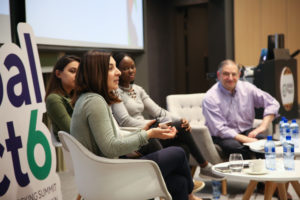Global Fact 6, the sixth international fact-checking summit hosted by Poynter’s International Fact-Checking Network, took place from June 19 through 21 in Cape Town, South Africa. This year’s event brought together the largest and most diverse pool of participants Global Fact has ever seen.
Here are nine takeaways from conversations, discussions and debates that were held between 40 sessions featuring 57 speakers.
Don’t sleep on social media
“People these days don’t want to read,” said Hannah Ojo at Thursday’s morning panel, New Solutions to Misinformation. Ojo, a TruthBuzz Fellow from the International Center for Journalists, said that the biggest mistake many fact-checking organizations make is not tailoring their content toward mobile formats.
“Whatever you’re doing, when you’re trying to get people on your phone, it has to be very brief, because their attention span is so short.”
Ojo shared some of the “social cards” she’s worked on with Africa Check in Nigeria, essentially infographics designed for social media platforms like Twitter, Instagram and Facebook that serve to inform readers briefly and efficiently.
Turn fact-checks into videos
Another strategy Ojo recommended was publishing fact checks in video format. She insisted that digital audiences are much more likely to watch a short explanatory video than they are to read an article.
Africa Check uses Lumen5, a video creation platform powered by artificial intelligence, to make their clips.

Gemma Mendoza, Govindraj Ethiraj, Tanya Pampalone, Batuhan Ersun and Tom Rosentiel speak at the panel, “Fact-Checking as a Tool for Holding the Powerful in Society Accountable.” (Uğurcan Akin)
At Tuesday’s Show & Tell Panel, Maarten Schenk, writer and chief technologist for Lead Stories of Belgium, shared a content management system he created to produce videos almost instantaneously. While they aren’t necessarily the most elegant — an AI voice reads the article as a slideshow of screenshots plays — for Schenk, they’re worth the trouble.
“Nobody views 90% of our videos,” he said. But with Lead Stories’ script, it’s so easy to create them that it’s worth the off chance one of them may go viral. The site’s YouTube channel has more than 800 of these clips, and while the majority have less than a handful of views, some have a few hundred, and others have more than 2,000.
Schenk pointed out that having an archive of fact-checks on YouTube is valuable, because sometimes people search up hoax stories on the platform. If Lead Stories’ fact-check appears in the results, it’s a sure way of steering users towards the right information.
Data from The Washington Post’s Fact Checker suggests these fact-checkers might be on to something. At his featured talk, Do Americans Believe Trump?, the Post’s Glenn Kessler mentioned that his site’s videos get five times as many views as articles.
Headline and pictures on Facebook
At a workshop on Wednesday, Jessica Collier from the Center for Media Engagement at the University of Texas at Austin and Joanna Sterling from Facebook presented some research findings that are helpful for fact-checkers seeking to increase their impact on Facebook.
Their first tip was that headline format matters. Of three different styles that were tested with users on Facebook, researchers found that wording headlines in the form of a refutation — “No, it isn’t true that X” — was the most surefire way of informing users. Both questions (“Is X true?”) and simple assertions (“X is not true”) were not as potent.
Sterling also added that carefully chosen pictures and logos can help users remember the information. Photos with humans at the center or with one clear, relevant focal point are ideal, and including a clear logo of the organization helps drive familiarity and trust.
She recommended keeping text to a minimum both in the headline and the image.
Consider your audience
At Tuesday’s Show and Tell, Katie Sanders and Aaron Sharockman of PolitiFact spoke about the TV show they launched with Newsy called “What the Fact.” With a budget of zero and 30 minutes of planning per episode, the show is extremely low maintenance, airing every Sunday. For half an hour, the two hosts debunk hoaxes, make jokes at each other and discuss recent fact checks for their audience.

Aaron Sharockman and Katie Sanders present during a Show & Tell session. (Uğurcan Akin)
Sanders and Sharockman pointed out that the people who read fact checks regularly aren’t always the ones who need them most, so the show has allowed PolitiFact to build a greater audience. They said television audiences tend to be less educated, not as concentrated in major cities, and generally distrustful of the media.
Hannah Ojo mentioned that Africa Check in Nigeria has tried to expand its audience by producing videos in pidgin English, a creole language common across the country. Since illiteracy in Nigeria is high, Ojo explained, it’s vital for the organization to be able to reach all sorts of demographics in the country, not just those who read English.
Engage younger generations
“We are the first version of history, and we have to make sure we get it right,” said Tanya Pampalone of the Global Investigative Journalism Network at a morning panel on Tuesday. “We owe that to future generations.”
Engaging with young people was a common thread amongst many of the fact-checkers’ conversations. One way Batuhan Ersun from Dogruluk Payi in Turkey treads a polarized political climate is targeting young audiences. They’ve tried to spread the word about misinformation among younger voters by holding workshops with students to teach them how to fact-check.
Use fact checks as diving points for in-depth reporting
At the same panel, Govindraj Ethiraj from the Spending & Policy Research Foundation in Mumbai, India, also spoke about the necessity of combining investigative journalism with data journalism. He explained that when the Indian government continued to repeat the claim that they’d built 90,000 toilets across the country, producing a simple fact check was both highly unfeasible and not effective enough in addressing the issue of hygiene.
While the number proved impossible to verify, it did lead to more on the ground reporting. Fact-checkers were able to uncover India’s hygienic infrastructure problems with more nuance, and show specific ways in which the government’s project was not working as well as they were claiming.
Take advantage of old fact checks
Ojo’s social cards from Africa Check in Nigeria used the hashtag #ICYMI (In Case You Missed It) as a way to make old fact checks resurface and educate their audience.
Lots of other organizations spoke about the importance of utilizing old fact checks. Chequeabot, Chequeado’s automated bot, has a feature where it tweets out reminders of old fact-checks when they become relevant in the news again.
Full Fact from the UK has also developed technology that can do real-time match claiming. Mevan Babakar, Full Fact’s head of automated fact-checking, explained that the system is not always perfect, but it makes it relatively easier to spot claims that have already been fact-checked, especially while live-checking parliamentary debates or other live speaker events.
Automate, automate, automate
Pablo Fernandez of Chequeado shared technology from Chequeabot that’s online and open to the public. “Please, never transcribe another YouTube video again,” he said, directing the audience to chequeado.com/trancriptor (or chequeado.com/desgrabador for Spanish).
Babakar of Full Fact shared a demonstration of Full Fact alpha, which translates speech to text and is able to immediately identify claims about unemployment or other national statistics and produce a verdict. This has been feasible for Full Fact because the statistics office of the UK has collaborated in making data readily accessible for AI tools.
She said she hopes that once the technology becomes more robust, “we can all start doing this. Not just the countries that have the luxury of statistical data in an API.”

Mevan Babakar speaks alongside Gülin Çavuş, Hannah Ojo and Mark Stencel at the panel New Solutions to Misinformation. (Uğurcan Akin)
Build a diverse team
Gulin Cavus of teyit.org in Turkey spoke about the difficulty of finding dedicated technicians who could help their organization develop new solutions and build innovative, technological tools. As a solution to this, Teyit organized a regional workshop that brought together specialists from a variety of fields, from academics and professors to social entrepreneurs, techies and designers.
“We know that we need a powerful community to fight against misinformation,” she said.
In her featured talk, Clara Jimenez Cruz of Maldito.es also invoked the strength of a tight-knitted community. She demonstrated how her organization had turned a crowdfunding model into a membership program, something that allowed her to draw on individuals’ support.
Subscribed Maldito.es members are all put together in a database, where they are able to connect with one another as well as share their specialties and expert knowledge with each other and with the organization. Cruz showed screenshots in which Maldito.es members had shared fact-checks with their family members in private WhatsApp group chats, an effective way of sourcing their audience’s help in fighting misinformation.
Celebrate your community
In her Show & Tell Presentation, Natalia Leal of Agencia Lupa spoke about how her team split up according to specialty in order to divide their efforts and fact-check the Brazilian elections. With one president, 500 congressmen and 27 state governors to vote for, the small group of fact-checkers had to work to their strengths to get the job done.
In two hours, the team was able to review 37 claims during a live debate, and the project enjoyed tremendous success on social media.
“Know your team and listen to them, don’t just command them to do things,” she told the crowd. “Let them participate in every step of the planning. And when you’re done, celebrate, because they deserve it.”






